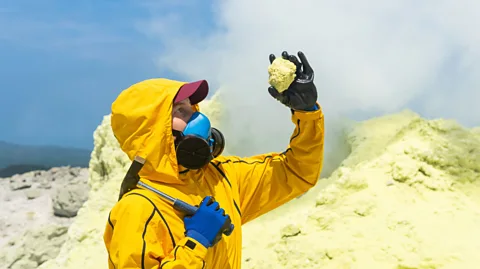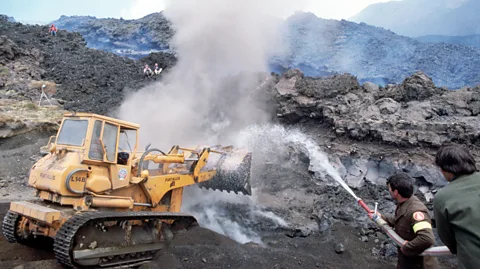Should we geoengineer volcanoes?

 Getty Images
Getty ImagesWe can already mitigate the worst effects of some volcanoes, but what if we could stop eruptions entirely? As Richard Fisher discovers, there are risks and ethical dilemmas to consider before we try.
One night in 1986, a cloud of CO2 gas emerged from an unsettled volcanic lake in Cameroon. It crept downslope, clinging to the ground, entering farms and buildings. What happened next was nothing short of horrific: more than 1,700 people and 3,000 livestock were suffocated.
The death toll from the disaster of Lake Nyos, caused by a so-called "limnic" eruption, was so high that scientists and engineers were tasked with preventing it happening again. Three years later, they began siphoning off the deadly gas from the bottom of the lake with a simple garden hose, which was followed later by bigger pipes. The procedure wasn't without risk – it's possible that the siphoning could have triggered another major gas release – but it worked. CO2 gas levels since then have been successfully controlled.
It's one of various example where "geoengineering" a volcano could save lives and prevent catastrophe. Over the years, various other approaches have been tried and proposed. For example, in Iceland, where a volcano began erupting spectacularly on the Reykjanes peninsula this week, the authorities have attempted to direct lava flows using mounds of rock. And in the 1970s, they attempted to use seawater to cool the outpourings of the volcano Heimaey. Elsewhere, such as Hawaii, planes have dropped bombs in the hopes of controlling volcanoes (unsuccessfully). And in the future, it's possible that drilling into magma chambers to degas them, or manipulating atmospheric sulphur emissions, could work.
However, all of these techniques pose risks as well as benefits, and the kinds of moral dilemmas that would make a philosopher scratch her head. In a recent paper, volcanologist Michael Cassidy of the University of Birmingham and his colleagues make the case for deeper exploration of the ethics of volcano geoengineering. The important question, they say, is not so much could we control volcanoes, rather should we?
 Getty Images
Getty ImagesHumans have been poking around inside volcanoes for at least a century – with mixed results.
In 1919, for example, a volcanic mudflow called a lahar killed more than 5,000 people at Mt Kelud in Indonesia. To avoid it happening again, engineers drilled tunnels through the crater to drain the lake. By the next eruption in 1951, the lake's volume had reduced by 90%, so the lahars were less destructive.
The drilling of Mt Kelud, however, also had unanticipated consequences. Over time, it unexpectedly deepened the lake, so that when it erupted in 1966, there was enough water and material in the subsequent lahars to kill 300 people.
Iceland volcano: Could it have been stopped?
This month, a major eruption in Iceland's Reykjanes peninsula forced the evacuation of the town of Grindavik. Could it have been geoengineered?
Stopping its eruption is beyond current technologies and knowhow, says volcanologist Michael Cassidy. "It's a fissure eruption, across a wide area, with a huge volume of magma," he explains. However, the Icelandic authorities have attempted to build mounds of rock to divert lava away from a geothermal power plant and the Blue Lagoon, a hydrothermal tourist spot. And if in future, the volcano kicked out harmful emissions, these could in principle, be controlled by sprinkling benign particles from a drone or aircraft, says Cassidy. Whether measures such as these should be done is, however, up for debate, he adds (see main story).
Sometimes, a volcano intrusion has been completely unintended. In recent years in Iceland, Hawaii and Kenya, operators at scientific and geothermal drilling sites have occasionally drilled accidentally into magma chambers. While the worst that happened was a frazzled drill-bit, these events have raised the question of whether penetrating a volcano's bowels could help mitigate their effects.
In general, though, volcanologists have been cautious about embracing geoengineering in their field, says Cassidy. Unlike other scientific disciplines where natural hazards are routinely controlled, such as wildfires, flooding or avalanches, the idea of blocking, bombing, or draining a volcano has been approached with far greater caution. "Volcanologists don't like to talk about it," he explains. "There's this notion that we can't do anything about the hazard: 'we're scientists, not interventionists'."
Since volcanology's birth as a fully-fledged scientific field in the mid-20th Century, the general principle has been precautionary, and "do no harm". On the website of the United States Geological Survey, for example, the idea of drilling to prevent an eruption of the Yellowstone supervolcano is dismissed, because "depressurising magma systems would have many unintended, negative consequences, including making an eruption more likely". How that'd happen is not described.
However, it's clear that volcano geoengineering could save many lives, if it could be done safely. As well as Yellowstone, there are supervolcanoes all over the world. In Italy, for instance, the enormous volcano Campi Flegrei has recently been rumbling beneath the homes and businesses of hundreds of thousands of people in Naples – and geologists fear an eruption could be imminent. And as the video below shows, there's one in New Zealand too:
Geoengineering could also mitigate wider catastrophic effects. Some volcanoes threaten impacts on a global scale, economically and climatologically. When Eyjafjallajökull in Iceland erupted in 2010, grounding thousands of planes across Europe, the costs ran in to the billions. Volcanoes in places like the Malacca Strait could paralyse global trade through shipping disruption.
Then there's the effects on the climate. The CO2 that volcanoes add to the atmosphere is dwarfed by human emissions. But every so often a big eruption can have a cooling effect by releasing Sun-blocking ash and aerosols. in 1816, for example, the northern hemisphere experienced the "year without a summer" following the atmospheric cooling of particles erupted by Mt Tambora, thousands of miles away.
And if you consider the scale of the biggest volcanoes across the whole geological record, global impacts could be far worse than these examples. In previous research, Cassidy and the existential risk researcher Lara Mani at the University of Cambridge have looked at the worst-case scenarios for a major global eruption in our hyper-connected world: global cooling of three degrees, a huge loss of agriculture, supply-chain collapses, and extreme weather conditions such as droughts or monsoons, for example. With some eruptions, everyone on Earth could be affected.
You may also like:
That's why Cassidy and Mani – along with the philosopher Anders Sandberg at the University of Oxford – argue that we ought to talk more openly about the possibilities and ethics of volcano geoengineering.
Volcano bombing
In World War Two, when the US was contemplating the nuclear bombing of Japan, one geologist proposed bombing Mt Fuji to trigger an eruption that would damage Tokyo. It apparently got as far as the White House, before it was rejected. In the UK, similar suggestions were made by MPs about the possibility of bombing Vesuvius near Naples, Italy.
There's no evidence it would have ever worked. "Unless the volcano was already preconditioned to erupt, I think it'd be unlikely to be triggered by a bomb," says Cassidy. And fortunately, the wording of the Geneva Conventions would prohibit such an attack today.
However, it's a chilling thought: what if some future weapons technology could allow governments to trigger volcanic catastrophes?
Cassidy and his colleagues make clear that they are not calling for its instant introduction in all cases: "The uncertainties and risks are far too large, and governance structures absent, to justify its deployment in the short-term," they write. As past efforts have shown, the unanticipated can and does happen when dealing with such a complex and powerful entity.
Take drilling into a volcano, for instance. A carefully-drilled borehole could in principle lower gas pressure, and make an eruption less explosive. And nothing happened when geologists accidentally penetrated magma chambers in Iceland, Hawaii and Africa. However, much remains unknown, and these non-events might not happen everywhere. "If you did this at a subduction zone volcano with much more volatiles, it might be quite different," says Cassidy. "Generally we have very little research on this."
Cassidy and colleagues argue two things: firstly, that there ought to be more (careful) research into the feasibility and safety of preventative efforts like magma drilling, as well as other techniques like cleaning the atmosphere of sulphur emissions. This could be done in the same way that researchers are tentatively exploring climate geoengineering: not bullish or reckless, but exploratory, with proper governance.
And second, that we need to explore the ethical quandaries such interventions would raise. For example, volcano geoengineering could involve deciding potential winners and losers. Even now with basic measures like building barriers to redirect lava flows, you can be faced with trolley-problem-esque quandaries like whether to send the lava to destroy one person's home to save five others. The seawater cooling at Heimaey in Iceland in 1973 posed such problems. Cooling it in one place to save the harbour led to pressure build-up elsewhere.
Legal ramifications could also arise: if interventionist authorities accidentally destroyed a building for the greater good, what compensation would they, or should they, pay out? What if they were falsely blamed for an eruption? Following the Italian earthquake in L'Aquila, six geologists were convicted of manslaughter. After they failed to predict the magnitude of the quake, the authorities blamed them for giving false reassurance (they were later exonerated).
 Getty Images
Getty ImagesNow imagine the ethical dilemmas on a global scale: would it be OK to put a local population of a few hundred, or even thousand, at risk of a geoengineering mistake if it could potentially prevent an international catastrophe affecting millions? What if there were cultural sensitivities to consider? Some volcanoes have religious importance for those living nearby, for example, which may discourage geoengineering.
These are age-old philosophical questions of ethics: when should you apply a deontological perspective (such as "it's always wrong to meddle with nature, and risk causing harm") vs a more consequentialist calculation ("do what leads to the most good"). There are no clear answers, but as Cassidy and colleagues point out, at present many volcanologists have embraced the first option without much debate.
The response to the disaster at Lake Nyos in Cameroon in the 1980s shows that, in some cases, volcano geoengineering can be done safely, and it can indeed save lives. And what made that example so striking was that it wasn't done with some futuristic sci-fi technology, meddling with nature – the gas, at first, was drained with a garden hose. Not all geoengineering would be so simple, of course, but in the face of looming eruptions perhaps it's time to weigh up the options.
*Richard Fisher is the author of The Long View: Why We Need to Transform How the World Sees Time, and a senior journalist for BBC.com. Twitter: @rifish
--
If you liked this story, sign up for The Essential List newsletter – a handpicked selection of features, videos and can't-miss news delivered to your inbox every Friday.
